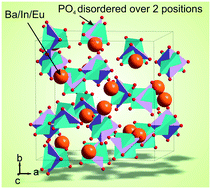Structural analysis and optical temperature sensing performance of Eu3+-doped Ba3In(PO4)3†
Abstract
Eu3+-Doped Ba3In(PO4)3 was synthesized through a high-temperature solid-phase method. According to the structure refinement based on X-ray diffraction and density functional theory, the crystal and energy band structures of Ba3In(1−x)(PO4)3:xEu3+ were studied and analyzed in detail. The effect of Eu3+ doping concentrations on emission was studied at an excitation wavelength of 393 nm. For the material Ba3In(1−x)(PO4)3:xEu3+(x = 0.01–0.30), the optimal doping level is confirmed to be 0.18. Due to the thermal quenching differences of Eu3+ at the 5D0 and 5D1 energy levels, and based on the temperature-variable fluorescence intensity ratio between emission peaks, the optical temperature measurement performance of this material in the temperature range from 298.15 K to 623.15 K was characterized, and the maximum absolute and relative sensor sensitivities (Sa and Sr) were determined to be 0.1002 K−1 and 4.058%, respectively. With temperature as the only variable, the color of the phosphor changes from red to yellow light with rising temperature. Besides, Sa and Sr values of this phosphor are comparable to other sensing materials. The results indicate that Eu3+-doped Ba3In(PO4)3 phosphors have great potential to be applied in optical temperature sensing.



 Please wait while we load your content...
Please wait while we load your content...